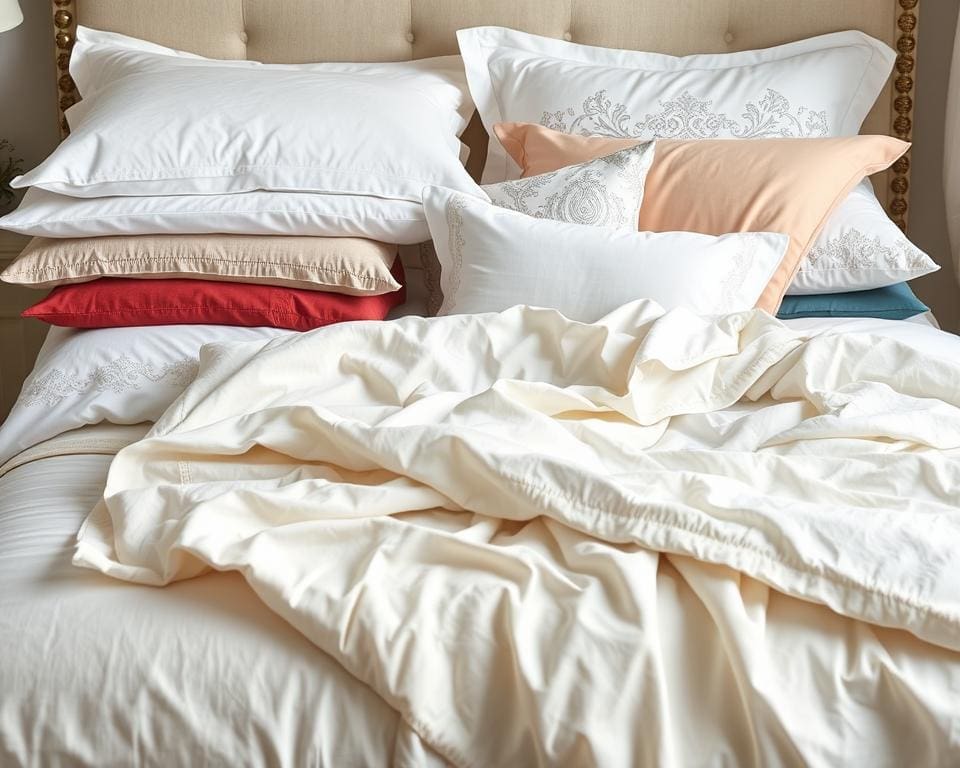Welcome to The Ultimate Guide to Buying Bed Linens, a comprehensive resource designed to elevate your understanding of bed linens and the significance of making informed choices. Selecting the right bed linens can vastly enhance your comfort, improve sleep quality, and transform the aesthetic appeal of your bedroom. This Bed Linens Buying Guide will unravel the complexities of various materials, styles, and maintenance tips, helping you to understand how to choose bed linens that truly meet your needs. By the end of this guide, you’ll possess the knowledge to create a serene and stylish sleeping environment.
Understanding Different Types of Bed Linens
When embarking on a journey to improve your sleep environment, understanding the various types of bed linens is essential. This knowledge empowers you to make informed decisions, enhancing both comfort and style in your bedroom.
Fitted Sheets vs Flat Sheets
Fitted sheets are tailored specifically to hug your mattress, featuring elastic corners that ensure a snug fit. This design offers a smooth sleeping surface, reducing the risk of bunching or shifting during the night. On the other hand, flat sheets serve a versatile purpose; they can act as a top layer or even a lightweight blanket. Choosing between the two depends on personal preference and desired functionality. For a complete sleep setup, consider having both fitted and flat sheets for the best Bed Linens Buying Tips.
Pillowcases and Shams Explained
Pillowcases are essential for protecting your pillows, providing hygiene and comfort during sleep. In contrast, shams are decorative covers that often enhance the aesthetic appeal of your bedding. While pillowcases prioritise practicality, shams focus on visual appeal. Understanding the difference between these two options allows consumers to curate a bed that not only feels delightful but looks inviting as well.

The Ultimate Guide to Buying Bed Linens
Making an informed decision when it comes to purchasing bed linens greatly enhances the quality of your sleep and the aesthetics of your bedroom. This section explores essential factors to consider before you embark on your shopping journey, as well as shedding light on the crucial aspect of thread count.
Factors to Consider Before Purchase
As you delve into the world of linens, consider the following factors to guarantee a satisfying purchase:
- Size Compatibility: Ensure the linens you choose fit your bed size, whether it’s a twin, double, or king.
- Intended Use: Differentiate between linens for everyday use and those meant for guests.
- Budget versus Quality: Set a budget while remembering that quality materials could enhance longevity and comfort.
The Importance of Thread Count
The concept of thread count plays a significant role in the Bed Linens Purchasing Guide. Generally, higher thread counts suggest a more durable and luxurious product. Yet, it’s essential to remember that thread count isn’t the only metric that determines quality. Factors such as the weave type and material should also be considered, as these elements impact the overall feel and functionality of your linens. A well-rounded understanding of thread count will empower you to make savvy selections that support a peaceful night’s sleep.
Choosing the Right Material for Your Bed Linens
When selecting bed linens, material choice plays a crucial role in quality and comfort. Understanding the differences between various fabrics can help you find the best options tailored to your needs. Whether you prefer the softness of cotton, the breathability of linen, or the easy maintenance of microfibre, knowing the characteristics of each material allows for informed decisions in line with the Best Bed Linens Tips.
Cotton, Linen, and Microfibre Differences
Cotton remains a popular choice, known for its natural origin and breathable qualities, making it ideal for a comfortable night’s sleep. Linen, derived from natural flax fibres, boasts a unique texture and is highly absorbent while getting softer over time. Microfibre, on the other hand, is a synthetic fabric that offers a budget-friendly alternative with minimal care requirements. When considering cotton, linen, and microfibre, each fabric’s properties will suit different preferences and lifestyles.
Natural vs Synthetic Fabrics
Natural fabrics, such as cotton and linen, often bring a sense of luxury and environmental consciousness to your bedding. They allow for better air circulation and are generally hypoallergenic, catering to sensitive individuals. Synthetic fabrics, including microfibre, can provide increased durability and ease of cleaning, appealing to those prioritising convenience. Evaluating the pros and cons of natural versus synthetic fabrics is essential in aligning your bed linen choices with personal preferences and needs.
Bed Linens Buying Tips for Allergies and Sensitivities
Selecting bed linens requires careful consideration, especially for individuals with allergies or sensitivities. Finding the right materials can greatly improve the quality of sleep while reducing discomfort. Keeping in mind essential Bed Linens Buying Tips can make all the difference in creating a restful environment.
Hypoallergenic Options
For anyone prone to allergies, exploring hypoallergenic options is crucial. Materials such as organic cotton and specific microfibres are designed to repel allergens effectively. These fabrics resist dust mites and other irritants, making them particularly suitable for sensitive skin. Choose products that explicitly state their hypoallergenic properties for optimal protection.
- Organic cotton offers breathability and natural resistance to allergens.
- Microfibre is often tightly woven, reducing the chances of allergen infiltration.
- Bamboo fabric is naturally antibacterial and hypoallergenic.
Understanding Fabric Allergies
Fabric allergies can arise from various materials, leading to discomfort or adverse skin reactions. Common culprits include synthetic fibres like polyester and certain dyes used in manufacturing. By recognising fabric allergies, consumers can avoid unpleasant reactions and foster a healthier sleeping environment.
- Identify symptoms such as rashes or irritation when using new linens.
- Opt for bedding labelled as free from harmful chemicals and dyes.
- Test bedding options prior to full investment to ensure compatibility.
Best Bed Linens Tips for Maintaining Quality
Maintaining the quality of bed linens ensures they remain fresh and comfortable for many nights to come. Proper care and storage not only enhance their longevity but also keep them looking pristine. Following the right washing instructions and storage techniques is crucial for preserving your investment in bed linens.
Washing and Care Instructions
Using appropriate washing instructions is essential to protect your bed linens from fading and shrinking. Consider these tips for optimal care:
- Wash linens separately on a gentle cycle to avoid friction with other fabrics.
- Select a mild detergent that doesn’t contain bleach to maintain colour and integrity.
- Use cold or warm water settings, as hot water may cause shrinkage.
- Air-dry when possible, or use a low heat setting in the dryer to prevent fabric damage.
How to Store Bed Linens Properly
Proper storage is vital for ensuring your bed linens are ready to use without any crumpling or mildew. Keep these bed linens care strategies in mind:
- Store linens in a cool, dry place, away from direct sunlight to prevent colour fading.
- Use breathable cotton or linen storage bags to allow air circulation.
- Avoid stacking too tightly; give linens room to breathe and prevent creasing.
Colour and Design Considerations for Bed Linens
When selecting bed linens, the aesthetic elements play a crucial role in transforming your bedroom into a personal sanctuary. Colour considerations can significantly influence the mood and atmosphere of the space. For instance, soft blues and greens are known for their calming effects, making them ideal for creating a relaxing retreat, while vibrant reds and yellows can inject energy and warmth into the room, providing a cheerful vibe.
Seasonal trends also offer exciting opportunities for expression through bed linens design. In the summer months, bold prints and bright colours can evoke a sense of liveliness, while autumn and winter often call for soothing neutrals and rich, deep colours that promote tranquillity. Embracing these trends can breathe new life into your space and keep your decor feeling fresh throughout the year.
Ultimately, selecting bed linens is not just a functional choice; it’s an expression of personal style. By considering how colours and patterns interact with your existing decor, you can curate a space that reflects your individuality. Remember these Top Bed Linens Selection Tips as you explore fabric options, ensuring that each piece complements your existing furnishings beautifully while offering an inviting atmosphere for relaxation and rejuvenation.









